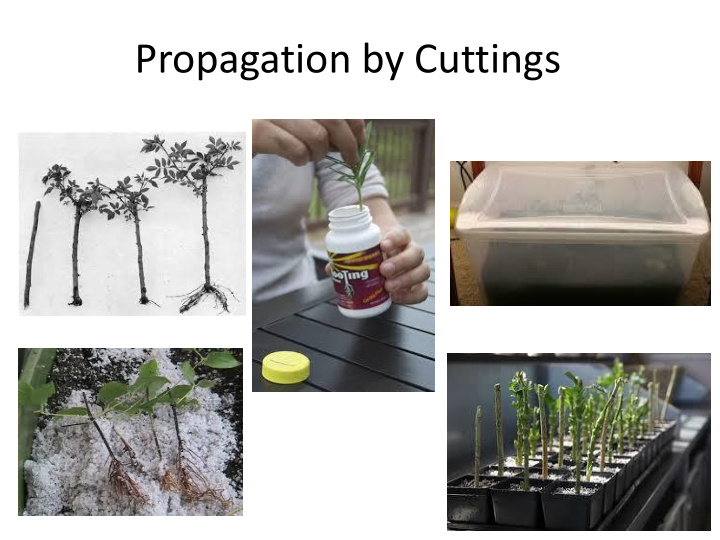



Propagation by Cuttings
Propagation by Cuttings • Rooting success is almost entirely dependent on controlling moisture, both in the potting media and in the atmosphere around your cuttings. Soil moisture and humidity are crucial. • The cuttings will rot if their soil is too wet. If it is too dry, the new roots will desiccate and die. Using a rooting media that maintains proper levels of air and moisture greatly increases rooting success. • When choosing a rooting medium you need to have a mix which allows for moisture to be retained, but one which does not allow the water to completely saturate the medium so that there is no air (oxygen) in the medium. • Texture or coarseness is an important factor in balancing these two requirements. The smaller particle sizes tend to allow the medium to become saturated, excluding all air and holding too much moisture. Larger particles will hold less moisture and allow air. Most sand is too fine to prevent saturation. Potting soils hold too much moisture. • Coarse vermiculite produces very good results. The coarse texture allows for good air penetration in the media, while the vermiculite holds the moisture. • A mix of 60% Perlite and 40% finer vermiculite also works well.
Propagation by Cuttings • If the humidity is too high, mold is a likely outcome, and if it is too low, the cuttings are at risk of desiccation before rooting occurs. • Humidity can be controlled in a greenhouse, or using something simple like a plastic storage box with the lid substantially closed. • Here I used a plastic bag over a black nursery pot.
Propagation by Cuttings Pre-rooting Cuttings • Wrap dormant cuttings in lightly dampened paper towels or newspaper. �� • Then place them in a sealed plastic bag and put them in a warm place. • In a few weeks, you will see root initials begin to form, and then roots. Be patient; each variety is different and each cutting, even when from the same tree, can differ in its response.
Propagation by Cuttings • Once the cuttings have formed roots they are removed from the bag for transfer to a clear cup. • This "bag" technique can be used on all sizes of cuttings. I have done some as large as 2" in diameter.
Propagation by Cuttings • Transfer the cuttings from bags to 26-oz. clear plastic cups containing a rooting medium and with holes drilled in their bottoms. • The pre-rooted cuttings are placed in these clear cups for further root development. Remember that deeper cups are better than short, squat cups.
Propagation by Cuttings • The pre-rooted cuttings in clear plastic cups are placed on wire racks, in plastic storage boxes. These boxes hold 20 cuttings and can be used to control humidity. • The screen "racks" are used to keep the cups above the water that collects at the bottom of the storage box. If the cups sit in water, the rooting media wicks up the water rotting the cuttings. But the water underneath the screen provides humidity to maintain moisture in the cutting.
Propagation by Cuttings • Place the box of cuttings in an area that receives filtered sunlight. Too much sun can heat up the box and “cook” your cuttings. • Open the lid of the box a little bit. This allows fresh air to enter, which is important in controlling mold. If the lids are wide open, you lose too much humidity. • The water at the bottom of the crate, under the screen, replenishes the humidity lost by having the lids open.
Propagation by Cuttings • Eventually the cuttings will develop roots. Each cutting may develop at a different rate. • An important principle to remember is that roots and leaves have no relationship to each other. • Under identical conditions, some cuttings will grow roots, some will grow leaves, and some will grow both.
Propagation by Cuttings • You cannot presume root development from observing leaf development. This is why clear cups are beneficial; they allow me to actually see whether roots are developing. • Here is a cutting that looked strong and healthy but there was little root development. This is not a good candidate for transplanting and should be kept in a very high humidity environment.
Propagation by Cuttings • This cutting has very • It is now removed from the cup vigorous root development and ready for repotting into a 1 seen through the cup as gallon pot. well as good leaf development.
Propagation by Cuttings • An advantage of vermiculite and perlite as a rooting medium is the ease of removing the rooted cutting for repotting. Mixes that contain organic materials tend to stick to the sides of the cups, which leads to root damage. • If the roots stick to the sides of the cup, squeeze and flex the cup. The sides of the cup can bend at sharp angles, and the roots will not. The cup may crack, but even cracked cups can be reused because they don't need to hold water.
Propagation by Cuttings • Transfer the cuttings to 1-gallon pots containing a potting mix of 60% Perlite and 40% potting soil. • Acclimate them to the outdoors, usually putting them in shade with augmented humidity for a few days, and gradually introducing them to more sunlight over a period of weeks. • At this stage, potting mix moisture control is still critical. Too much moisture will still cause root rot and plant failure. • When I see roots in the drain holes, I transfer the trees to 2-gallon pots while reversing the mix to 40% perlite and 60% potting soil.
Propagation by Cuttings
Recommend
More recommend